Welcome! If it’s your first time here, you might want to subscribe to my free monthly newsletter. Thanks>
* Cheeks skewered with spears.
* Backs pierced with double rows of finger-size hooks.
* Chests and stomachs buried by small silver cups or citrus fruits held on with fine hooks.
* Tongues pierced with sets of delicate silver skewers.
* Men strapped into elaborate, colorful 5-8 ft-tall ‘floats’.
* Others carrying heavy, arched wooden palanquins decorated with peacock feathers and bright colors.
* Still others dressed in bright orange fabrics, carrying pots of milk atop their heads.
* Raucous Indian music, played by live musicians in traditional attire.
* People dramatically smashing coconuts on the streets.
* Thousands of onlookers dressed in vibrant silk saris, wearing fragrant white jasmine flowers in their hair.
——————————————————————————–
This is the Indian Thaipusam festival, a dramatic, chaotic, noisy tribute to the Hindu God Murugan.
But what does it all mean? Why are hundreds of people undergoing such extreme piercings, bearing heavy burdens, and walking miles in the blazing sun?
Last week I attended Thaipusam in Penang, Malaysia. During the festival, I asked several Indian participants what it’s all about. I clarified their responses with a little online research. Here’s what I learned.
Thaipusam Festival is celebrated mainly by Tamil Indians on full moon in the Indian ‘Thai’ month- the first month of their calendar year- which falls in January or February. ‘Thai’ is God Murugan’s month.
Other Hindu Gods have a corresponding month during the year, and often festivals are conducted in honor of those Gods during their particular months.
Thaipusam is celebrated in India at 6 major Murugan Temples plus in large Tamil communities abroad, particularly in Malaysia, Singapore, Sri Lanka and Mauritius.
Devotees are fulfilling their vows of ‘bearing burdens’ to Lord Murugan to show thanks for their prayers being answered. Generally, they have previously prayed to avert some serious trouble, hardship, or disaster.
In exchange for their ‘favor’ being granted, they’ve promised to make particular offerings to Murugan. If such problems are indeed resolved, and their prayers answered, the devotees then ‘suffer burdens’ to demonstrate their profuse gratitude.
All such burdens are called ‘Kavadi’. They range from carrying a simple pot of milk to offer Murugan to carrying heavy wooden palanquins on their shoulders to undergoing various piercings to bearing tall heavy ‘floats’. Many walk barefoot. They march several miles in the hot blazing sun.
Each devotee is accompanied by an assistant or a whole group of supporters who egg them on, protect them from throngs of onlookers, and give them sips of water. Most walk in silence, to more completely focus on God and their vows. Those with pierced tongues and cheeks literally cannot talk.
Devotees must undergo elaborate rituals before and during Thaipusam. For 48 days leading up to the festival, they must eat only particular vegetarian foods and practice celibacy.
It’s believed that they pass into an ecstatic trance-like state, sometimes breaking into fervent dancing, and occasionally becoming possessed temporarily by Gods.
Thaipusam lasts 2-3 days. It begins at dawn with prayers and rituals at a designated Hindu temple, amidst throngs of people. Once completed, the Thaipusam procession kicks off with two colorfully decorated cows pulling a silver chariot, which bears a statue of Lord Murugan. They proceed slowly through the streets several miles to the final Lord Murugan temple.
In Penang, the parade begins in central Georgetown’s Little India and proceeds about 7 km to the Waterfall Temple, near Penang Botanical Gardens.
Thousands of people, dressed in brilliantly colored saris and other traditional outfits, escort the chariot and line the parade route. Hundreds approach the chariot with offerings of fruit and flowers.
Attendants on the chariot collect their offerings then bless the devotees. Consequently, the chariot must stop frequently, making the procession a long, grinding all-day affair.
In Penang, it takes over 12 hours for the chariot to reach the Waterfall Temple. Layed out along the entire parade route are piles of coconuts, tall and small. They are decorated with incense, flowers, and sometimes orange coloring.
A few minutes before the chariot reaches each coconut pile, people start grabbing coconuts and smashing them open dramatically on the street. Apparently, that symbolizes cracking open one’s skin to reveal one’s true inner self, in pure white.
After each coconut smashing ‘party’ a clean-up crew quickly moves in with small bulldozers, street cleaners and brooms to whisk it all away before the chariot arrives. It’s all creates a big frenzy.
Traditional Indian musicians and drum troupes join the parade. Dozens of devotees carry large curved wooden kavadi. All along the route, temples and businesses have already set up stands offering free food, water, fruit, snacks and drinks to everyone in attendance.
The last few miles leading up to Waterfall Temple, the road is lined with large, bright booths blasting loud Indian music, offering more food and drink, and adding to the intense visual and auditory overload. The festival continues on through the night.
On the second morning, devotees who’ve vowed to undergo piercings and/or to carry large strapped-in floats make their preparations, receive piercings, get strapped in, and start their long march to the temple, amid more throngs of onlookers.
When they finally arrive, they present themselves to Lord Murugan. Their vows have been fulfilled. Floats are dismantled, broken up, and discarded. Piercings are removed. Devotees can relax… almost.
The night of the full moon, Lord Murugan’s silver chariot, the devotees, and masses of on-lookers march all the way back to the original temple, arriving near dawn the following morning.
QUESTIONS:
What do you think of Thaipusam?
Would you like to see it in person?
————————————————————————————–
You might also like:
Photo Gallery: Thaipusam Festival in Penang
———————————————————————————————————-






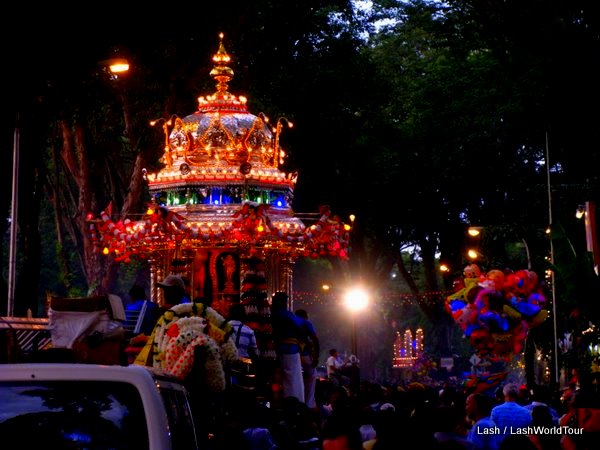
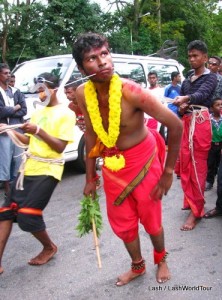
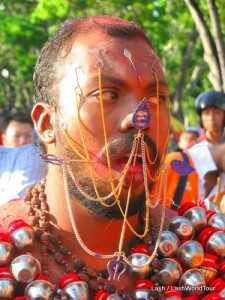
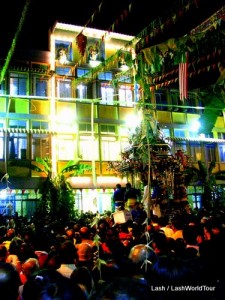
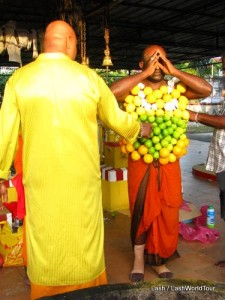
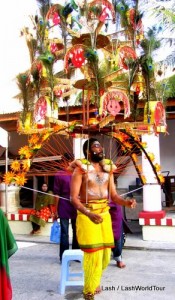
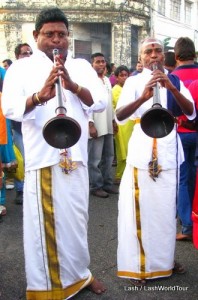

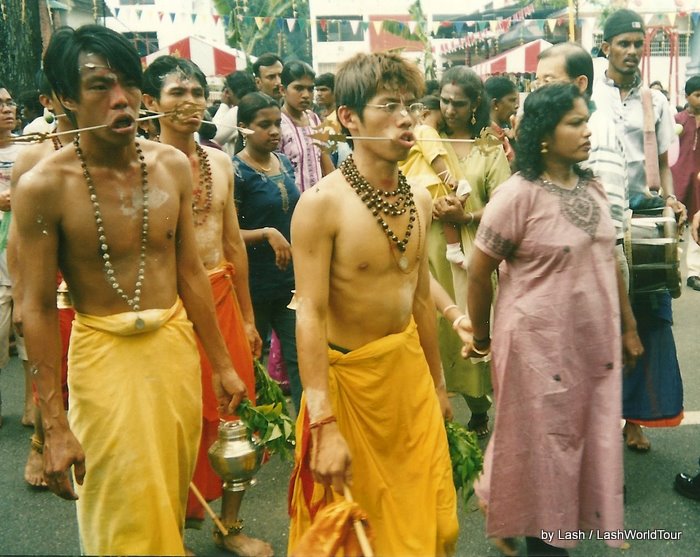



 Hi! I'm Lash, an American nomadic world traveler who's been traveling solo since 1998. I’m passionate about traveling the world nomadically and then sharing it all with you. I hope to inspire you to travel the world, to entertain you with tales from the road, and to help you reach your travel dreams. Welcome!
Hi! I'm Lash, an American nomadic world traveler who's been traveling solo since 1998. I’m passionate about traveling the world nomadically and then sharing it all with you. I hope to inspire you to travel the world, to entertain you with tales from the road, and to help you reach your travel dreams. Welcome! 




1 pings
Photos of Thaipusam Festival in Penang - Malaysia » LashWorldTour
2014/01/18 at 9:09 am (UTC 8) Link to this comment
[…] Thaipusam Festival Explained […]